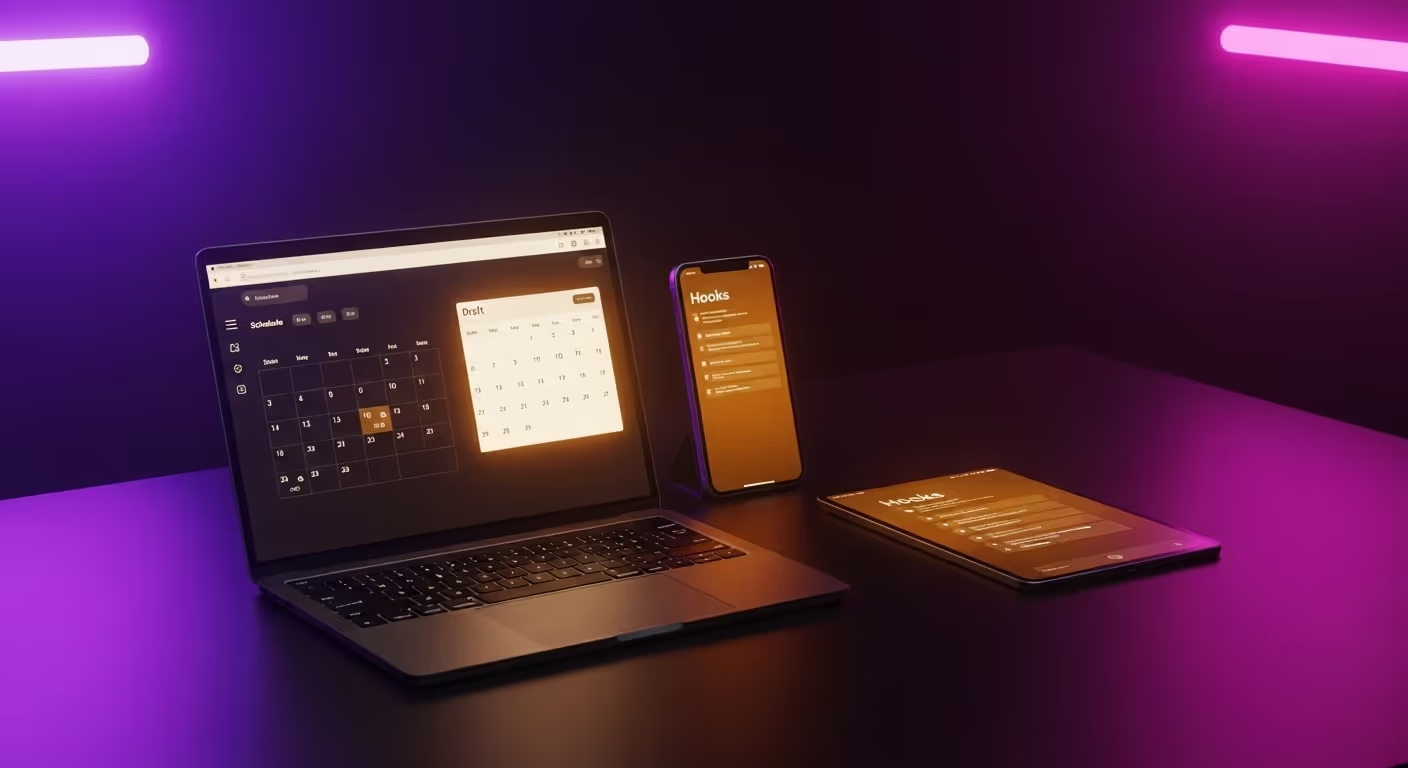
Social
A 30-day social plan you can keep
A simple monthly calendar for Facebook, Instagram, and TikTok. Clear themes, quick prompts, and a workflow you can repeat without burning out.

The plan in one line
Run one clear theme each week and one clear format each day. Keep it light, repeatable, and tied to results. This is a calendar you can follow without guesswork, with posts that take hours, not days.
The weekly themes
Pick four themes that match your offer and your audience. Use one theme per week so your ideas stay focused and easy to plan.
- Week 1: Proof. Results, behind the scenes, and fast wins.
- Week 2: Teach. Short how to tips and checklists.
- Week 3: Product or service. Features, benefits, and use cases.
- Week 4: Community. Team notes, UGC, reviews, and events.
If you post for multiple brands, swap the theme names, but keep the flow: proof, teach, offer, community.
The daily formats
Use the same pattern every week so you never start from zero. Adjust the idea, not the format.
- Mon: Carousel or multi image. Value in steps or a list.
- Tue: Short tip post. One clear idea with a save worthy line.
- Wed: Reel. A hook, a point, a quick call to action.
- Thu: Photo post. Human, product in use, or behind the scenes.
- Fri: FAQ post. One common question with a clear answer.
- Sat: Story series. Three to five frames; poll or question at the end.
- Sun: Reel or recap. A quick win or a weekly digest in one clip.
Hooks that work across platforms
Good hooks start strong, promise a clear gain, and speak like a person. Keep them short and front loaded.
- Stop doing this if you want [result]
- Three quick fixes for [pain]
- You asked this all week: [question]
- The fastest way to [task]
- One small change that grew [metric]
Write three hook options per post. Use the best one after a quick read aloud test.
Captions that people finish
Use a tight pattern: hook, proof, value, next step.
- Hook: The first line must say the point. Keep it short.
- Proof: One stat, one example, or one real quote.
- Value: The tip, list, or steps in simple words.
- Next step: Save, share, comment, or click.
Keep lines short. Break text for mobile. Use emojis only when they help scanning.
How to batch one month of content in two hours
This is the workflow you can run on a timer. It is fast and it holds quality.
- Pull inputs from your website, blog, and recent questions. Add any event dates or offers.
- Fill the calendar with the four weekly themes and the seven daily formats.
- Write hooks for every post. Three per post. Pick the strongest later.
- Draft captions with the hook, proof, value, and next step pattern.
- Create assets in batches. Carousels as one batch. Reels as one batch. Photos as one batch.
- Schedule everything in one sitting using your planner. Add the story series as well.
- Set comment sweeps twice a day. Morning and late afternoon.
Reels without the headache
Reels work when you lead with the point and keep cuts tight. Use simple setups you can repeat.
- Face to camera single tip: Hook in four words, one tip, one line next step.
- Over the desk: Show screen or notebook with a voiceover.
- Before and after: One shot shows the problem, next shot shows the fix.
- List in cuts: Three clips, one line each. Add native captions.
Keep clips short. Use native text. Add auto captions. Post and move on. The goal is steady volume that matches your weekly theme, not a perfect film.
Carousels that people save
Carousels earn saves when each slide tells a clear step. Use large type and simple grids.
- Cover: State the promise in one line.
- Slides 2 to 6: Steps or points. One idea per slide.
- Final slide: Quick recap and a next step.
Keep the same template for the month. Change colors and images by theme so the feed looks fresh but the work stays fast.
Stories that people finish
Stories do well when they feel close and simple. Use short frames and a small arc.
- Day in the life: Three frames from morning, mid day, and end of day.
- Quick tip: One frame sets the tip, one frame shows it, one frame adds a poll.
- Event push: Map, time, and a last chance line.
- Proof: Share a small win and tag the source when you can.
Add a poll or question at the end two or three days per week. Use the replies to plan future posts.
Approval flow that does not slow you down
Keep approvals simple so schedules hold.
- Share the monthly calendar view with labels for each theme and format.
- Send a compact preview of carousels and captions in one link.
- Limit review to one pass. Collect notes in one place. Freeze after that pass.
For reels, send a low resolution preview. Fix subs and hook if needed. Then post at the set time.
Publishing and timing
Timing still matters. Use platform insights and your past posts to pick two daily windows that match your audience. Keep a steady rhythm and avoid posting three items back to back on one platform unless it is an event day.
- Facebook: Mid morning and early evening work well for most local brands.
- Instagram: Late morning and late afternoon are safe tests.
- TikTok: Evenings and weekends often perform better.
Test small changes before you switch the whole plan. Track the lift at the post level and the week level.
Comment sweeps and DMs
Set two short windows per day to reply. Keep replies human and short. Move complex asks to email or a form. Hide spam fast. Log common questions. Those become future posts and FAQs.
What to track each week
Track a few simple numbers. Enough to guide choices. Not so many that you slow down.
- Reach: Unique accounts reached by format.
- Saves and shares: Best signs that a post helped.
- Profile actions: Clicks to site, messages, follows.
- Completion rate: For reels and stories.
Pick one goal for the month. Follows, reach, or site clicks. Tie next month’s plan to that goal and the week that drove it most.
How to turn blog posts into social in minutes
Use your blog as a source of ideas and proof. One post can feed a full week of social.
- Carousel: The main steps from the article.
- Tip post: One insight in one line.
- Reel: Host reads the three key points in short cuts.
- Story series: A quick question, a poll, and a result.
- FAQ Friday: One question the article answered.
Link back in your bio or use a simple link hub. Track clicks on that hub. If one topic drives most clicks, write more on it next month.
Creative rules that keep quality up
- Light the face, clean the background, and crop tight.
- Use your brand colors and one type scale so the grid looks consistent.
- Keep on screen text short and readable on a phone.
- Use native captions on reels so people who mute can still follow.
- Shoot more than you think you need so you can cut without gaps.
Plan for event days
When you have an event, shift the week to support it. Use a simple arc: tease, reveal, remind, recap.
- Tease: Date and hint in a story and a post.
- Reveal: Details with a map, time, or offer.
- Remind: Last chance post on the day.
- Recap: Photos or a short reel with one line of text.
What to cut when time is tight
If you must cut, keep the theme and the reel. Drop one post midweek and keep the story series on the weekend. You need one strong video touch and two to three feed posts per week to stay present.
Simple monthly recap
At the end of the month, run a short review.
- Top three posts by saves and shares.
- Top reel by completion rate.
- Top caption by link clicks or replies.
- One lesson to carry into next month.
Set next month’s single goal and switch only one variable at a time. For example, test a new hook style for the full month while you keep formats the same.
Template you can copy
Week 1: ProofMon CarouselTue Tip postWed ReelThu Photo postFri FAQSat Story seriesSun Reel or recapWeek 2: Teach[Same formats, new topic]Week 3: Product or service[Same formats, new topic]Week 4: Community[Same formats, new topic]
Final note
This plan is simple by design. Your audience gets steady value. You get a clear system that does not stall. Keep the weekly theme, keep the daily formats, and keep posting on schedule. Then use your recap to improve the next month one change at a time.
read more
Similar articles

Find Anyone Faster with LinkedIn AI Search

Your marketing plan for Sora AI video
Let’s grow
Start your monthly marketing system today
No guesswork, no back-and-forth. Just one team managing your website, content, and social. Built to bring in traffic and results.




